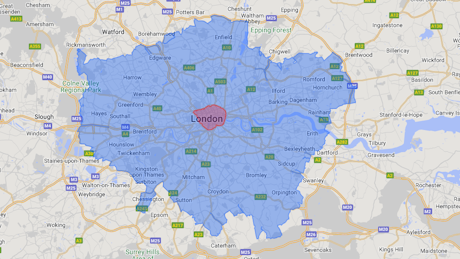London’s Ultra Low Emissions Zone (ULEZ) explained
September 21, 2023 by carwow staff

What is the ULEZ?
London’s Ultra Low Emissions Zone (ULEZ) was introduced in April 2019 in an effort to improve air quality in central London by cutting the number of older, more polluting cars taking journeys through the capital. The charge is £12.50 for cars, motorcycles and vans.
The ULEZ first occupied the same small, central area as the London Congestion Charge zone, but in October 2021 was expanded significantly to include all areas inside the North and South Circular ring roads.
As of 29 August 2023, the ULEZ has been expanded again to take in almost all areas inside the M25, a vast area with millions of people living in it.
Petrol cars not meeting Euro 4 emission standards, and diesels not meeting Euro 6 regulations (see below for more details on this) are subject to a £12.50 daily charge for driving into the ULEZ. While precise dates vary, as a rule of thumb petrol cars sold prior to 2005, and diesels built prior to 2015, are subject to the charge, which operates on a 24/7 basis. Our handy ULEZ checker will tell you if your car is compliant.
The ULEZ charge runs alongside the Congestion Charge (CC) – which cut private car usage by 39% between 2002 and 2014, according to stats from the London Assembly. However, the ULEZ runs 24/7, 364 days a year (with Christmas Day the sole exemption) rather than operate from 7am to 10pm like the Congestion Charge. The congestion charge zone has not been expanded though, it still only covers a small area of central London.
What about the LEZ?
Lorries, vans and trucks over 3.5 tonnes, and buses, minibuses and coaches over five tonnes do not have to pay the ULEZ. They do, however, have to pay the Low Emission Zone (LEZ) charge. The LEZ is not to be confused with the ULEZ, with the LEZ not applying to cars and vans under 3.5 tonnes. The LEZ covers most of greater London, and costs £100 a day. Unless you drive a lorry, bus, large van or specialist vehicle like a snow plough or concrete mixer, you don’t need to worry about it.
Is my car ULEZ compliant?
The ULEZ specifically targets older cars, motorcycles and vans with high emissions, and the basis for determining this is a set of regulations called ‘Euro standards’.
Euro standards are, as the name suggests, Europe-wide emission regulations that all new cars must meet. The standards tighten up periodically, reducing the amount of pollutants a new car can emit before it is approved for sale, with the first Euro standard being introduced in 1992 and the current, Euro 6 regulations, coming in in 2014.
Euro standards first apply to cars that are put forward for ‘type approval’ – this is the process a brand-new model that has been launched by a manufacturer must go through before it is allowed to be put on sale.
Cars put forward for type approval from 2014 must meet Euro 6 standards, but cars that had already been type approved prior to this date could continue to be sold from new while not meeting Euro 6 until September 2015; this is why it is tricky to give a definitive answer with regard to what Euro standard a car meets.
Similarly, Euro 4 standards were introduced in January 2005 for new type approvals, but cars that did not meet Euro 4 but that had already been type approved could continue to be sold from new up to January 2006.
The ULEZ is clearly is much tougher on diesel cars, then, as these need to be from 2015 onwards in order to escape the charge. This is because the nitrogen dioxide and particulate matter (microscopic soot) older diesels emit is known to be particularly bad for human health. Emission control systems like selective catalytic reduction (commonly known as AdBlue) and diesel particulate filters address these issues, though, with these systems being fitted to Euro 6 diesels, hence their compliance with the ULEZ.
Non-compliant vehicles under 3.5 tonnes are subject to the £12.50 charge. Large vehicles (categorised as being over 3.5 tonnes for lorries and coaches or buses over 5 tonnes) that do not comply will be subject to a £100 charge each day they enter the ULEZ.
Transport for London (TfL)’s exact standards are:
- Euro 3 (NOx) for motorcycles, mopeds, motorised tricycles and quadricycles
- Euro 4 (NOx) for petrol cars, vans and other specialist vehicles (up to and including 3.5 tonnes gross vehicle weight) and minibuses (up to and including 5 tonnes)
- Euro 6 (NOx and PM) for diesel cars, vans and other specialist vehicles (up to and including 3.5 tonnes) and minibuses (up to and including 5 tonnes)
-

Where is the ULEZ now?
Originally, the ULEZ operated in the same area as the Congestion Charge — as far north as St Pancras, east to Shoreditch, south to Vauxhall and west to Mayfair. On 25 October 2021 though, the zone was greatly expanded to the North and South circular roads within the capital.
On 29 August 2023, the ULEZ was expended again to include almost everything inside the M25 orbital motorway. The zone now stretches as far as Newham, Lewisham, Haringey and Brent. Our handy ULEZ checker shows you the exact boundary of the ULEZ and tells you whether your vehicle is compliant or not.

There’s no physical barrier preventing you from entering the ULEZ, rather it’s well signposted as you approach the zone and policed by hundreds of number-plate reading cameras. If your car isn’t compliant and you don’t pay the entry fee, you’ll find a penalty notice land through your letterbox.
The fine for not paying the ULEZ charge is £160, though is reduced to £80 if you pay it within 14 days.
Why does London have a ULEZ?
The idea behind the ULEZ is to reduce the negative effect on the health of people in London that can be attributed to poor quality air, while also promoting the use of public transport. Amongst other things, the ULEZ aims to limit harmful pollution such as Particulate Matter, NO2 and CO2 gases.
How much does the ULEZ cost?
Non-compliant cars entering the ULEZ need to pay a £12.50 charge that runs concurrently with the £15 Congestion Charge. That £12.50 charge allows cars to drive in the ULEZ for a 24-hour period, meaning you will need to pay each day you are in the zone in a non-compliant car.
The only exception goes to owners of cars registered with ‘disabled’ or ‘disabled passenger vehicles’ tax – they’ll be exempt from paying the ULEZ until 26 October 2025.
London black taxis under 15 years old are also exempt, although any Taxi sold after 1 January 2018 has to be Zero Emission Capable – i.e. able to travel at least 20 miles on electric power alone and produce CO2 emissions of less than 75g/km.
Will I be fined for entering the ULEZ without paying?
If your vehicle is non-compliant with ULEZ standards, you must pay the charge. Failing to do so will result in a fine landing in the post. For cars, this means a £160 charge — though it will be reduced to £80 if it’s paid within 14 days. You can challenge the fine if you feel it has been wrongly issued, however.
Can I get a grant to buy a ULEZ compliant car?
With the end of the Plug-in Car Grant for electric cars, you can’t even get a grant for an EV any longer, let alone a ULEZ compliant car. There is however a £110m ULEZ scrappage scheme which allows you to scrap your non-ULEZ compliant car and replace it with one which meets the necessary standards.
Is the ULEZ the same as the congestion charge?
No. The ULEZ and the Congestion Charge now cover different areas, and have different criteria. If you drive into the Congestion Charge (CC) zone during its hours of operation (7am-6pm Mon-Fri, 12pm-6pm weekends) you will have to pay both the CC and the ULEZ. If you drive into the ULEZ in a non-compliant car but don’t ender the CC zone, you only need to pay the ULEZ.
Which other cities in the UK have a ULEZ?
No other towns or cities in the UK have schemes that are as wide-ranging as the ULEZ. Other cities do have Clean Air Zones (CAZ), though.
Birmingham’s CAZ covers a small area within the A4540 Middleway ring road. As with the ULEZ, the Birmingham CAZ operates 24.7 and applies to pre-Euro 4 petrol cars and pre-Euro 6 diesels. It costs £8 a day.
Bristol’s CAZ came into force in November 2022and charges private cars not meeting the Euro 6/4 standards £9 a day to enter the zone, which covers a small central part of the city.
Bradford, Portsmouth and Bath have Clean Air Zones, but they do not apply to private cars or motorbikes – only taxis, vans and buses/HGVs.
Sheffield has plans for a CAZ that will not affect private cars, and the same goes for Newcastle & Gateshead.
Greater Manchester’s CAZ is ‘under review’, and it is unclear if a scheme will go ahead.
Stay up to date on all things ULEZ by signing up to our ULEZ newsletter
Car Change? Carwow!
Looking for a new set of wheels? With Carwow you can sell your car quickly and for a fair price – as well as find great offers on your next one. Whether you’re looking to buy a car brand new, are after something used or you want to explore car leasing options, Carwow is your one stop shop for new car deals.















